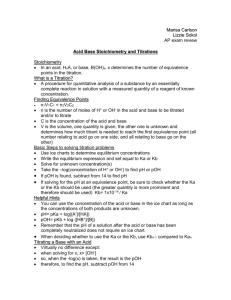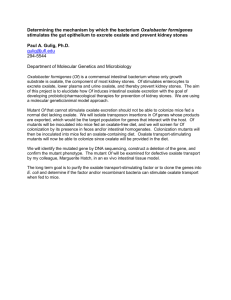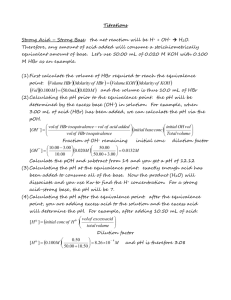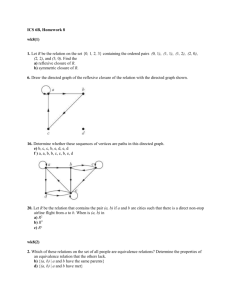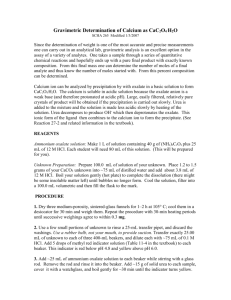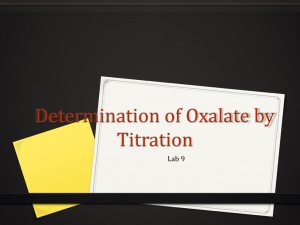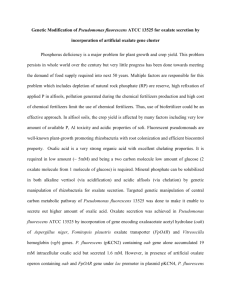NAME: Chem 1a, 3rd
advertisement
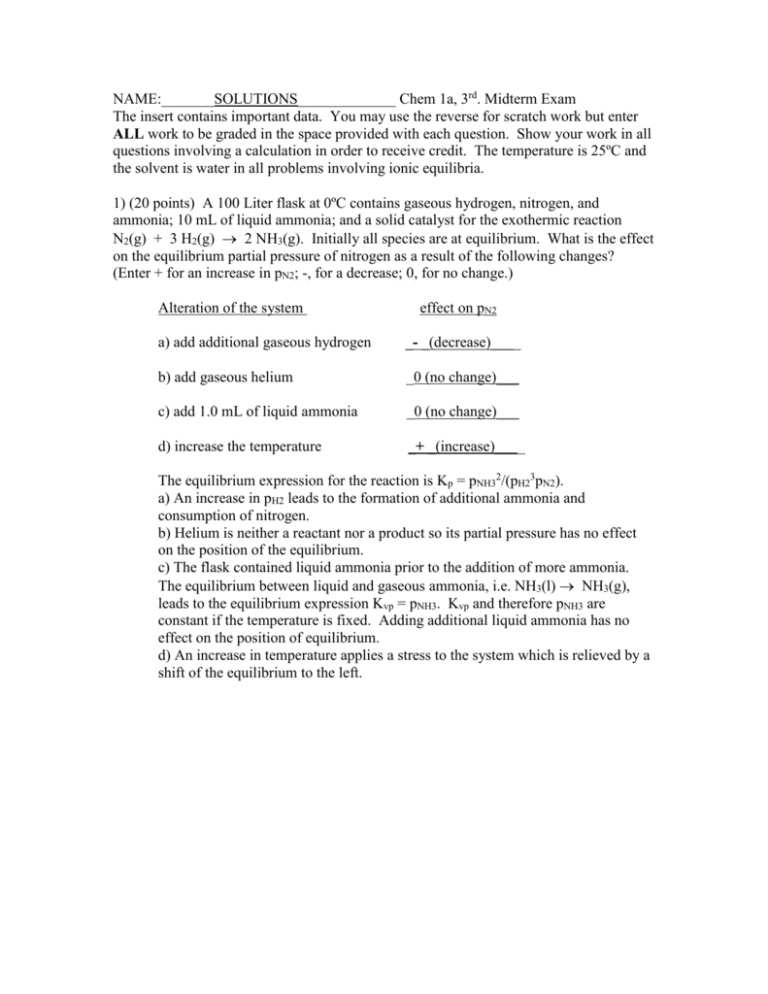
NAME:_______SOLUTIONS_____________ Chem 1a, 3rd. Midterm Exam The insert contains important data. You may use the reverse for scratch work but enter ALL work to be graded in the space provided with each question. Show your work in all questions involving a calculation in order to receive credit. The temperature is 25ºC and the solvent is water in all problems involving ionic equilibria. 1) (20 points) A 100 Liter flask at 0ºC contains gaseous hydrogen, nitrogen, and ammonia; 10 mL of liquid ammonia; and a solid catalyst for the exothermic reaction N2(g) + 3 H2(g) 2 NH3(g). Initially all species are at equilibrium. What is the effect on the equilibrium partial pressure of nitrogen as a result of the following changes? (Enter + for an increase in pN2; -, for a decrease; 0, for no change.) Alteration of the system effect on pN2 a) add additional gaseous hydrogen _- _(decrease)____ b) add gaseous helium _0 (no change)___ c) add 1.0 mL of liquid ammonia _0 (no change)___ d) increase the temperature _+ _(increase)____ The equilibrium expression for the reaction is Kp = pNH32/(pH23pN2). a) An increase in pH2 leads to the formation of additional ammonia and consumption of nitrogen. b) Helium is neither a reactant nor a product so its partial pressure has no effect on the position of the equilibrium. c) The flask contained liquid ammonia prior to the addition of more ammonia. The equilibrium between liquid and gaseous ammonia, i.e. NH3(l) NH3(g), leads to the equilibrium expression Kvp = pNH3. Kvp and therefore pNH3 are constant if the temperature is fixed. Adding additional liquid ammonia has no effect on the position of equilibrium. d) An increase in temperature applies a stress to the system which is relieved by a shift of the equilibrium to the left. 2) (45 points) This problem deals with a 0.50 M solution of the base ethylamine, CH3CH2NH2. The pKa of its conjugate acid, CH3CH2NH3+, is 10.68. a) Determine the value of the equilibrium constant for the reaction CH3CH2NH2(aq) + H3O+(aq) CH3CH2NH3+(aq) + H2O(l) The reaction is the reverse of the reaction which defines Ka, namely CH3CH2NH3+(aq) + H2O(l) CH3CH2NH2(aq) + H3O+(aq). The equilibrium constant for the reaction is the inverse of Ka: K = 1/Ka = 1/10-pKa = 10pKa = 1010.68 = 4.8 x 1010. b) Calculate the pH of the solution. The problem requests the pH of a 0.50 M aqueous solution of the base ethylamine. This is a pure base problem. The relevant reaction is CH3CH2NH2(aq) + H2O(l) CH3CH2NH3+(aq) + OH-(aq) For which Kb = [CH3CH2NH3+][OH-]/[CH3CH2NH2] (eqn 1). Kb = Kw/Ka = (1.0 x 10-14)/( 10-10.68) = 4.8 x 10-4<<1. We have a weak base but not a very weak base. Therefore, [CH3CH2NH3+] = [OH-] and [CH3CH2NH2]0 [CH3CH2NH2]. Equation (1) simplifies to 4.8 x 10-4 = [OH-]2/(0.5 M), a result which yields [OH-] = 0.015 M. The pOH = -log10[OH-] = 1.81 and the pH = 14.00 – pOH is 12.19. 3) (45 points) The task in this problem is the preparation of a pH 7.00 buffer. a) The insert provides a list of acids and their pKa’s. Select the acid best suited for the preparation of the buffer. Provide the basis for your selection. The best choice is dihydrogen phosphate whose pKa, 7.21, lies closest to the target pH. b) Suppose that you are provided a 0.10 M solution of the acid selected in part (a) [Solution A] and 0.050 M NaOH (Solution B). Calculate the volume of Solution A that would yield the desired buffer when it is mixed with 250 mL of Solution B. The predominant species in the buffer will be dihydrogen phosphate and monohydrogen phosphate. The relevant reaction is H2PO4-(aq) + H2O(l) HPO4-2(aq) + H3O+(aq) for which Ka = 10-7.21 = [H+][HPO4-2]/[H2PO4-]. Substituting [H+] = 1.00 x 10-7 M, one obtains the ratio [HPO4-2]/[H2PO4-] = 0.62. The 250 mL of solution B contains (0.250 mL)(0.05 M) = 0.013 moles of OH-. Sufficient solution A must be added to react completely with the base, producing 0.0125 mole of HPO4-2. However, an excess of solution A must be added so that at the end one has (0.013)/0.62 = 0.022 moles of H2PO4-. One requires therefore sufficient solution A to provide 0.013 + 0.022 = 0.035 moles of H2PO4-. This requires a volume of (0.035 mole)/(0.1 M) = 0.35 L. 4) (30 points) The solubility product of the mineral fluorite, CaF2, is 1.46 x 10-10. Calculate the solubility of fluorite in a) pure water The relevant reaction is CaF2(s) Ca+2(aq) + 2 F-(aq) so Ksp = 1.46 x 10-10 = [Ca+2][F-]2. In part (a) the fluorite is the sole source of fluoride so from the stoichiometry of the reaction 2[Ca+2] = [F-]. Substituting this result in the Ksp expression yields 1.46 x 10-10 = 4[Ca+2]3. One quickly obtains the solubility, [Ca+2] = 3.3 x 10-4 M. b) 0.20 M potassium fluoride In part (b) the same Ksp expression applies but now the dominant source of fluoride is the fluoride present in the solution prior to adding the fluorite. Therefore, 1.46 x 10-10 = [Ca+2][0.20 M]2. One quickly obtains the new solubility, [Ca+2] = 3.7 x 10-9 M. By the common-ion effect, the solubility of fluorite has been suppressed. 5) (50 points) This problem deals with a 1 M solution of oxalic acid, a diprotic acid with the structural formula HOOC-COOH. [Relevant pKa’s can be found on the insert.] a) In the space provided below, carefully sketch the concentration of HOOC-COOH (use a solid __________ line), -OOC-COOH (use a dashed - - - - - - - - - line), and -OOC-COO(use a dotted . . . . . . . . . . . line) as a function of pH. To make the plot, one must recognize that the dominant species in the region between low pH and the first equivalence point are undissociated oxalic acid and monohydrogen oxalate. The dominant species between the first and second equivalence points are monohydrogen oxalate and oxalate. The dominant species above the second equivalence point is oxalate. Construction of the plot is enabled by results are 6 points: a) Pure oxalic acid in water. This is a pure acid problem. To a first iteration, [H+] = (Ka1[H2A]0)0.5 or pH = 0.5pKa1 since [H2A]0 = 1 M. This yields pH 0.6, a number close to zero; a cycle of successive approximations yields a revised value for the pH, 0.7, and [H+] = [-OOC-COOH] = 0.21 M and [HOOC-COOH] = 1.00 – 0.21 = 0.79 M. b) The first halfway point is at pKa1 = 1.24 where [-OOC-COOH] = [HOOC-COOH] = 0.5 M. c) The first equivalence point where the dominant species is -OOC-COOH is given by pH = 0.5(pKa1 + pKa2) = 2.71. d) The second halfway point is at pKa2 = 4.19 where [-OOC-COO-]= [HOOC-COO-] = 0.5 M. e) At the second equivalence point, oxalate is the dominant species. We have a pure base problem and the standard methods yield pH 9.10. With these results one can construct the required plot. The concentration of oxalic acid is 0.79 M at pH 0.7, drops to 0.5 M at pH 1.23, and is very small at the first equivalence point. The concentration of monohydrogen oxalate is 0.21 M at pH 0.7, reaches 0.5 M at pH 1.23 and its maximum of nearly 1 M at the first equivalence point, drops to 0.5 M at pH 4.19, and is very small by the second equivalence point. The concentration of oxalate is very low until after the first equivalence point. It climbs to 0.5 M at pH 4.19 and nearly 1 M at the final equivalence point. Connecting these points in a manner with no wiggles and discontinuities yields the desired plots. Note well. A distribution plot, not a titration curve was requested. b) Estimate the concentrations of the two most abundant oxalate species at pH 5.0. The pH lies between the second halfway point at pH 4.19 and the second equivalence point at pH 9.10. The dominant species are monohydrogen oxalate and oxalate. A calculation is not needed here. Simply read the points off the graph which can be sketched. One obtains [-OOC-COO-] 0.8 M and [HOOC-COO-] 0.2 M. THIRD MIDTERM EXAMINATION CHEMISTRY 1a, FALL, 2008 CORRECTED INSERT TABLE OF pKa’s OF SELECTED ACIDS Acid Name of the Acid H2O water -2 HPO4 monohydrogen phosphate HTeO4 monohydrogen tellurate HCO3monohydrogen carbonate NH4+ ammonium HSeO3 monohydrogen selenite H2PO4 dihydrogen phosphate H2TeO3 tellurous acid C2H4O2 acetic acid C2HO4- monohydrogen oxalate C2H4O3 glycolic acid C2ClH3O2 chloroacetic acid HSO4monohydrogen sulfate C2H2O4 oxalic acid HIO3 iodic acid pKa 14.00 12.32 11.00 10.33 9.25 8.32 7.21 6.27 4.76 4.19 3.83 2.69 1.98 1.23 0.78


